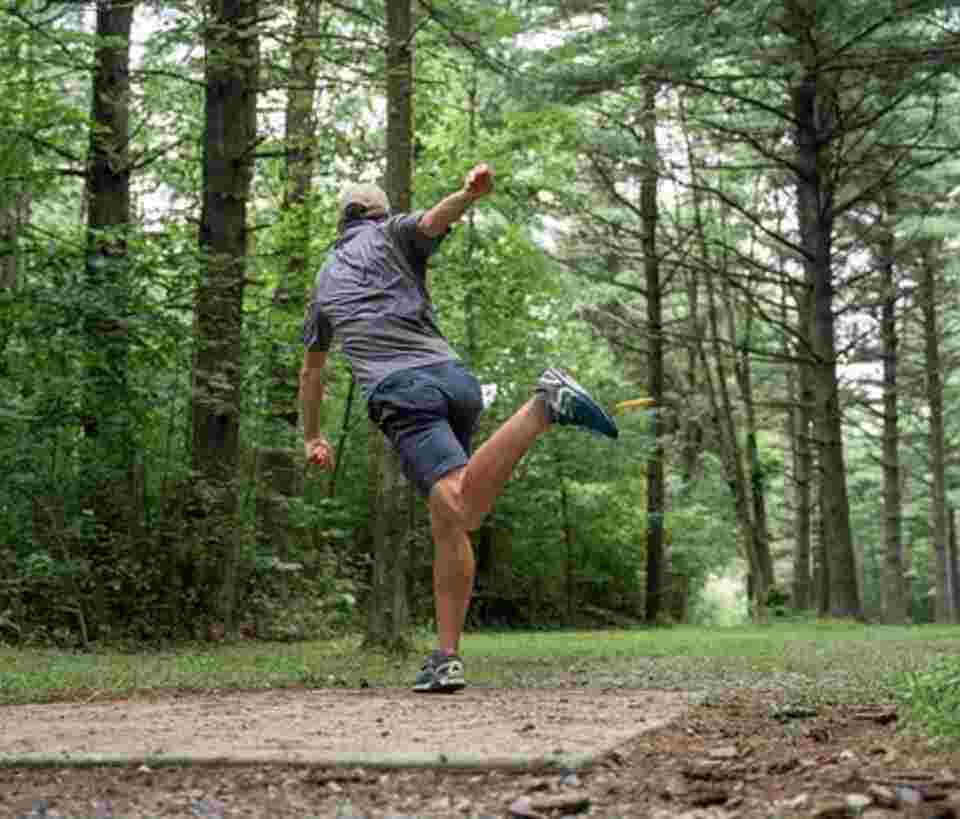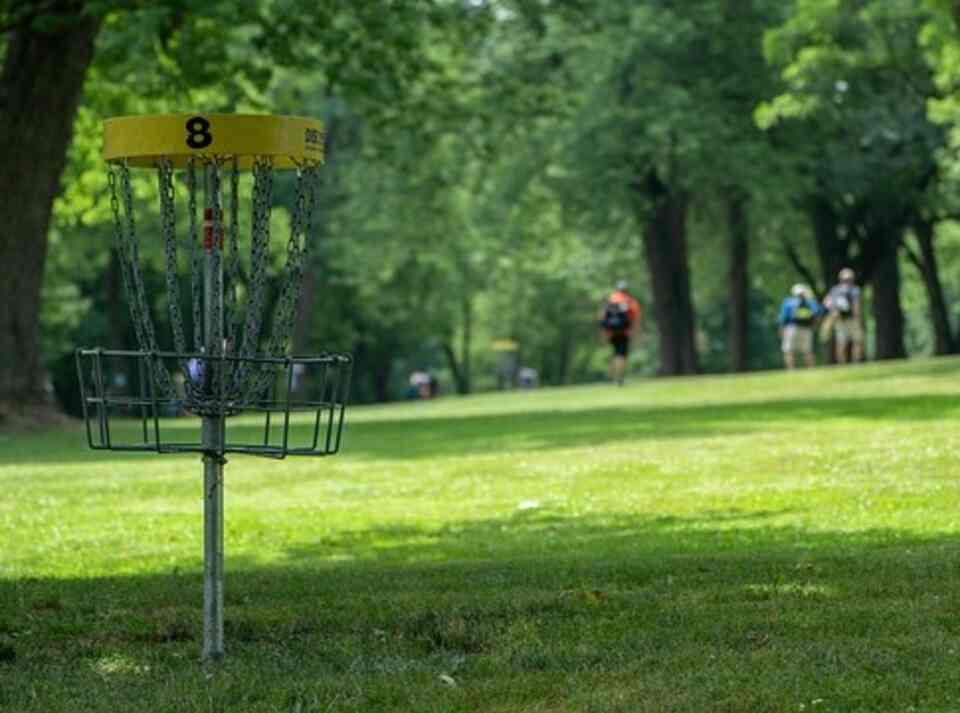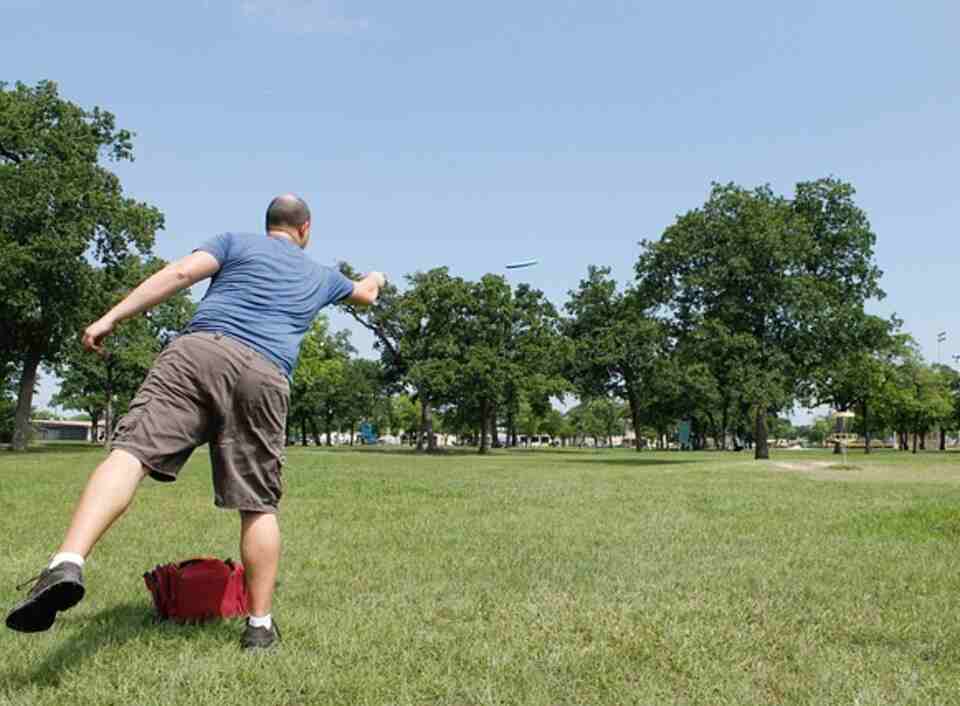Welcome to my comprehensive guide on understanding what is fade in disc golf. In this article, I will cover everything you need to know about this important concept in disc golf and how it affects the flight of a disc. Whether you’re a beginner or an experienced player, understanding fade is crucial for improving your game and making informed decisions on the course.
Key Takeaways:
- Fade refers to the leftward movement of a disc at the end of its flight in disc golf.
- It is one of the flight ratings used to describe a disc’s flight characteristics, along with speed, glide, and turn.
- Fade is rated on a scale from 0 to 5, with higher numbers indicating a stronger leftward movement.
- The Innova Flight Ratings System is a way to describe a disc’s intended flight, with fade being one of the categories.
- Fade can be influenced by factors such as disc design, plastic type, and throwing technique.
Now that you have a brief introduction to fade in disc golf, let’s dive deeper into the concept and how it impacts your game.

The Innova Flight Ratings System Explained
The Innova Flight Ratings System is a comprehensive way to describe the flight characteristics of disc golf discs. It consists of four main categories: Speed, Glide, Turn, and Fade. Each of these ratings provides valuable information about how a disc is intended to fly, allowing players to make informed decisions when selecting discs for different shot types and distances.
The Fade rating specifically refers to the disc’s tendency to hook left (for right-handed backhand throws) at the end of its flight. It is rated on a scale from 0 to 5, with higher numbers indicating a stronger fade. Discs with a higher fade rating will have a more pronounced leftward movement, while discs with a lower fade rating will have less leftward movement.
Understanding the fade rating of a disc is crucial for controlling the landing position of the disc. For example, if a player needs a disc to finish to the left, they can choose a disc with a higher fade rating to ensure a more reliable leftward movement at the end of the flight. On the other hand, if a player wants a disc to finish straight or to the right, they can opt for a disc with a lower fade rating. The fade rating can be influenced by various factors, including disc design, plastic type, and throwing technique.

To further illustrate the flight characteristics associated with different fade ratings, the table below provides a visual representation:
| Fade Rating | Flight Path |
|---|---|
| 0 | Straight finish or slightly right |
| 1 | Slight left finish |
| 2 | Moderate left finish |
| 3 | Strong left finish |
| 4 | Very strong left finish |
| 5 | Extreme left finish |
By understanding the Innova Flight Ratings System and specifically the fade rating, disc golfers can make more precise shot selections, control their throws, and shape their shots to suit different course conditions. It is important to experiment with different discs and understand how the fade rating interacts with other flight ratings to optimize performance on the disc golf course.
Understanding Disc Golf Flight Numbers
In disc golf, flight numbers are used as a standardized way to communicate a disc’s flight characteristics. These numbers provide valuable information about a disc’s speed, glide, turn, and fade. When it comes to fade, the fourth number in the flight ratings sequence, it describes the disc’s tendency to hook left (for right-handed backhand throws) at the end of its flight.
The fade rating is essential for disc golfers because it helps them predict and control the disc’s landing position. A disc with a higher fade rating, such as 4 or 5, will exhibit a more pronounced leftward movement, while a disc with a lower fade rating, such as 0 or 1, will have less fade and tend to finish straighter.
Understanding the fade rating is crucial for selecting the right disc for different shot types and conditions. For example, when players need a disc to finish left around obstacles or navigate a dogleg fairway, a disc with a higher fade rating can be advantageous. On the other hand, shots that require a straighter finish or minimal leftward movement may call for a disc with less fade.
| Flight Numbers | Speed | Glide | Turn | Fade |
|---|---|---|---|---|
| Example Disc | 9 | 5 | -1 | 2 |
Table: Example flight numbers for a disc with a speed of 9, glide of 5, turn of -1, and fade of 2.
By familiarizing themselves with flight numbers and understanding the fade rating, disc golfers can make more informed decisions on the course. It’s important to note that these flight numbers are provided by disc manufacturers and are intended as guidelines, as individual throwers may experience slight variations in flight patterns based on their technique and arm speed.
Impact of Plastic Types on Disc Golf Fade
When it comes to disc golf, the type of plastic used to make a disc can have a significant impact on its flight characteristics, including the fade. Different plastics can affect a disc’s stability, wind resistance, and overall durability. Understanding the influence of plastic types on fade can help players make informed decisions when selecting discs for their game.
Generally, discs made from premium plastics like Champion and Glow Champion tend to have less high-speed turn and more fade compared to discs made from other plastics such as Star, GStar, and Driver Pro. This means that discs made from premium plastics are more stable and have a stronger leftward movement at the end of their flight. The increased fade can be advantageous for players looking to control their shots and ensure a consistent leftward finish.
On the other hand, discs made from plastics like Star, GStar, and Driver Pro tend to have less fade and offer more glide. These discs are often preferred by players who are looking for more distance and straighter flights. The reduced fade allows for a smoother and controlled flight path, making it easier to shape shots and navigate tight fairways.
| Plastic Type | Fade |
|---|---|
| Champion | High |
| Glow Champion | High |
| Star | Low |
| GStar | Low |
| Driver Pro | Low |
It’s important to note that while plastic type does contribute to a disc’s fade, other factors such as disc design and throwing technique also play a role. However, understanding the impact of plastic types on fade can help players make more informed choices when building their disc golf bag and selecting the right disc for each shot.
“The choice of plastic can make all the difference in controlling the fade of a disc. Premium plastics like Champion and Glow Champion provide a reliable and consistent leftward finish, while plastics like Star and GStar offer more glide and less fade. It’s important for disc golfers to experiment with different plastics and find the ones that best complement their throwing style and desired flight path.” – Disc Golf Pro
Disc Golf Discs for Different Levels of Players
In disc golf, the fade of a disc plays a crucial role in shaping shots and controlling the disc’s landing position. Understanding the importance of fade can help players of different skill levels make informed decisions when selecting discs for their game.
For more experienced players who have developed a high level of control over their throws, discs with a higher fade rating can be advantageous. These discs are designed to exhibit a significant leftward movement at the end of their flight, allowing players to shape shots around obstacles or achieve a specific landing position. Spike and skip shots, for example, often require a consistent leftward finish, which can be achieved with discs that have a higher fade rating.
On the other hand, beginners and players who are still developing their throwing technique may benefit from discs with less fade. Discs with lower fade ratings are generally easier to control and have less tendency to hook left at the end of the flight. This can help beginners maintain a straighter flight path and improve their accuracy. As players progress and gain more control over their throws, they can gradually transition to discs with higher fade ratings to add more shot-shaping options to their game.
Factors to Consider
When choosing disc golf discs based on fade, it’s important to consider other flight characteristics as well. Discs with high fade ratings often have other characteristics that complement their leftward movement, such as high speed and low turn. These discs are typically designed for maximum distance but may require more arm speed and throwing power to achieve their full potential.
On the other hand, discs with lower fade ratings often have more neutral flight characteristics, making them suitable for a wider range of players. These discs can offer a good balance between distance potential and control, allowing players to execute accurate shots without sacrificing too much distance.
| Disc Type | Fade Rating | Player Level |
|---|---|---|
| Distance Driver | High | Experienced players |
| Mid-range Disc | Moderate | All skill levels |
| Putter | Low | All skill levels |
All skill levels refers to players of any experience level, from beginners to advanced players who have mastered their technique.
By understanding the role of fade in disc golf and considering factors like skill level and disc type, players can make informed choices that align with their game and help them achieve their desired outcomes on the course.

Factors Influencing Fade in Disc Golf
In disc golf, the fade of a disc can be influenced by several factors, including the disc’s design, plastic type, and throwing technique. Understanding these factors can help players improve their control and accuracy when it comes to fade.
Disc Design: The design of the disc, particularly the rim shape, can have a significant impact on the amount of fade it exhibits. Discs with a sharper and more angular rim tend to have a stronger fade, while discs with a more rounded rim may have less fade. It’s important for players to experiment with different disc designs to find the right balance of fade for their throwing style and shot selection.
Plastic Type: As mentioned earlier, the type of plastic used to make a disc can affect its flight characteristics, including the fade. Premium plastics such as Champion and Glow Champion tend to have more fade compared to plastics like Star, GStar, and Driver Pro. The choice of plastic type can depend on factors such as wind conditions, disc stability, and desired shot shape.
Throwing Technique: The way a player throws a disc can also influence the amount of fade it exhibits. Factors such as arm speed, release angle, and throwing angle can all impact the disc’s flight and the degree of leftward movement at the end. Players can experiment with different techniques and adjustments to optimize their fade control and achieve desired shot outcomes.
| Factors Influencing Fade in Disc Golf | Impact on Fade |
|---|---|
| Disc Design | Rim shape can affect the amount of fade exhibited. |
| Plastic Type | Premium plastics tend to have more fade compared to other plastics. |
| Throwing Technique | Factors such as arm speed and release angle can influence fade. |
By considering these factors and how they interact with each other, players can gain a deeper understanding of the fade in disc golf and make more informed decisions in their disc selection and throwing techniques. Experimentation and practice are key to finding the right balance of fade for different shot types and conditions, allowing players to maximize their control and performance on the course.

Using Fade to Control Disc Golf Shots
In the game of disc golf, mastering the concept of fade is crucial for players looking to take their skills to the next level. Fade, the leftward movement of a disc at the end of its flight, can be a powerful tool in controlling shots and achieving desired landing positions. By understanding how to utilize fade, players can navigate obstacles, shape shots, and set up for optimal putting positions.
“Fade can be an essential tool for disc golfers to control their shots and land the disc in a desired position.”
One of the key benefits of understanding fade is the ability to adjust throwing and release angles to manipulate the leftward movement. By analyzing the fade characteristics of different discs, players can choose the ideal disc for each shot type and distance. Discs with a higher fade rating, such as distance drivers, can be valuable for shots that require a consistent leftward finish, like spike and skip shots. On the other hand, discs with less fade, such as putters and mid-range discs, are often recommended for beginners as they are easier to control and have less tendency to hook left at the end of the flight.
Factors such as disc design, plastic type, and throwing technique can influence the amount of fade exhibited by a disc. Experimenting with different discs and understanding these factors can help players gain a deeper understanding of how to control fade to their advantage. With practice and experience, players can become more adept at utilizing fade to shape their shots, overcome obstacles, and achieve greater precision in their disc golf game.
Fade in Different Disc Golf Disc Types
When it comes to disc golf, understanding the flight characteristics of different disc types is essential for mastering the game. One important factor to consider is the fade, which refers to the leftward movement of a disc at the end of its flight. Fade ratings can vary across different disc types, allowing players to choose discs that suit their specific needs and shot types.
The table below provides an overview of the fade characteristics for different disc golf disc types:
| Disc Type | Fade Rating |
|---|---|
| Distance Drivers | High Fade (3-5) |
| Mid-Range Discs | Moderate Fade (2-4) |
| Putters | Low Fade (0-3) |
The table provides a general guideline for fade ratings across disc types, but it’s important to note that individual discs within each category may have slight variations in their fade ratings. Players should consider their own throwing style and preferences when selecting discs.
For distance drivers, which are primarily used for long-range shots, a higher fade rating (3-5) can be beneficial. The strong leftward movement at the end of their flight helps players shape their shots and control the disc’s landing position. On the other hand, mid-range discs and putters have lower fade ratings (0-3) to allow for more accuracy and control when approaching the basket or putting.
By understanding the different fade characteristics across disc types, players can make informed decisions about which discs to use for various shot types and distances. Experimenting with different discs and finding the right balance of fade can greatly enhance a player’s overall performance on the disc golf course.
Conclusion
In conclusion, understanding fade in disc golf is essential for players of all skill levels. Fade refers to the leftward movement of a disc at the end of its flight and is one of the flight ratings used to describe a disc’s flight characteristics. By considering the flight ratings, plastic types, and individual disc characteristics, players can make informed decisions when selecting discs and adjusting their throwing technique.
Discs with higher fade ratings are useful for experienced players who can control their throws and utilize the leftward movement to shape their shots. On the other hand, beginners may prefer discs with less fade as they are easier to control and have less tendency to hook left. By understanding the fade characteristics of their discs, players can adjust their throwing angles, release angles, and power to manipulate the leftward movement and control their shots.
Factors such as disc design, plastic type, and throwing technique can influence the amount of fade a disc exhibits. It is important for players to experiment with different discs and understand how these factors contribute to the fade in their throws. With practice and experience, players can master the nuances of fade in disc golf and use it to improve their overall performance on the course.
FAQ
What is fade in disc golf?
Fade in disc golf refers to the leftward movement of a disc at the end of its flight.
What are the flight ratings used to describe a disc’s flight characteristics?
The flight ratings used to describe a disc’s flight characteristics are speed, glide, turn, and fade.
How is fade rated?
Fade is rated on a scale from 0 to 5, with higher numbers indicating a stronger fade.
How does fade influence the landing position of the disc?
Fade is important for controlling the landing position of the disc.
What factors can influence the fade of a disc?
Factors that can influence the fade of a disc include disc design, plastic type, and throwing technique.
Which plastic types have more fade in disc golf?
Discs made from premium plastics such as Champion and Glow Champion generally have more fade compared to discs made from other plastics like Star, GStar, and Driver Pro.
Who can benefit from discs with a higher fade rating?
More experienced players who can control their throws can benefit from discs with a higher fade rating.
Why are discs with less fade recommended for beginners?
Discs with less fade are generally recommended for beginners as they are easier to control and have less tendency to hook left at the end of the flight.
How can players manipulate the fade of a disc?
Players can adjust their throwing angles, release angles, and power to manipulate the fade of a disc.
Which disc types have more fade in disc golf?
Distance drivers tend to have a higher fade rating, while putters and mid-range discs tend to have less fade for controlled and accurate shots.


